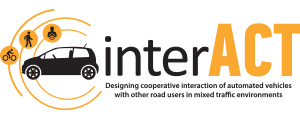Impact of the project results
Increasing road safety
We evaluated the interACT solutions by using computer simulation to consider all possible manoeuvres currently conducted on the road by traffic participants to assess the safety of the interACT solutions for ensuring collision avoidance. We also investigated the perceived safety of surrounding road users, while they interacted with our Automated Vehicle, which incorporated eHMI, designed to communicate the intentions of the Automated Vehicle. Results suggest that both the presence of an eHMI and slightly exaggerated yielding decelerations may improve the subjective experience of Automated Vehicle safety for pedestrians. The interACT safety layer uses formal methods proving that the vehicle never causes an accident, no matter how vulnerable road users are moving. This has been realized by a set-based prediction of surrounding traffic participants and the generation of fail-safe maneuvers of the automated system. These fail-safe maneuvers ensure the availability of safe actions even if vulnerable road users behave unexpectedly.
Increasing user-acceptance and ease-of use of Automated Vehicles
The project considered road-based, human-human interactions, user requirements and expectations throughout the whole design process. We assessed the final interACT solutions, comparing them to Automated Vehicles without additional communication cues, considering the needs of both onboard users, and other traffic participants, especially Vulnerable Road Users. Based on the evaluation results, the eHMI solutions developed in interACT, and tested in a range of settings, were positively evaluated by participants, suggesting that the inclusion of eHMI could lead to increased acceptance of, and higher satisfaction for, Automated Vehicle interactions. The visibility of eHMI solutions, and their ability to relay consistent and reliable information, are important considerations in this context, to ensure both positive user evaluations and road user safety.
Improving validation procedures for Automated Vehicles
The interACT partners worked on a range of methodologies to test and assess cooperation strategies, and investigate safe interactions between an Automated Vehicle, the on-board user, and other road users, in order to help improve the validation procedures for Automated Vehicles. Further, the project provides novel, on-the-fly techniques for manoeuvre and trajectory planning, that reduce the need for exhaustive testing all possible road scenarios. In order to demonstrate that our on-the-fly techniques for manoeuvre and trajectory planning work, we have created several hundred realistic test scenarios. This database is online available at https://commonroad.in.tum.de/. We have also used this database in a student competition, in which we received more than 20.000 submissions. Educating students about safe vehicle automation is believed to be another major contribution of interACT.
A detailed review of appropriate methodologies suggests that a combination of data collection techniques was required, and thus the project made use of pedestrian simulator, driving simulator, test-track, and real-world, wizard-of-oz studies. The studies also developed a number of new methods and measures, to capture crossing times and durations (see D6.2). Quantitative models of human-Automated Vehicle interactions at pedestrian crossings and vehicle intersections were used to develop simulations of the traffic flow efficiency impacts of the interACT solutions. These models can be used to capture the quality of the interactions between Automated Vehicles and humans.
Raising awareness for the integration of Automated Vehicles in mixed traffic environments
During the project run time, interACT evaluated, demonstrated and disseminated its project results in two demonstrator vehicles, several research simulators and many dissemination events and conferences to raise awareness of the interACT solutions that were developed to allow the safe, cooperative and intuitive integration of Automated Vehicles in mixed traffic environments.
Supporting the leadership position of the European vehicle industry
The interACT project enables its industrial partners to fully exploit project findings, increasing the potential safety benefits, sales, and adoption of Automated Vehicles. With leading manufacturers such as BMW, BOSCH, CRF, and HELLA on board, the project ensures that results are integrated at a fast pace, allowing Europe to remain at the forefront of this type of research. For several technical developments the TRL level was increased in the three years of the interACT project. E.g. a new light component, the directed signal lamp, was developed as prototype and installed at the BMW demonstrator vehicle for the first time in the project and with this an important step on the product development path was made (TRL 2- TRL 6). Further, the Cooperation and Communication Planning Unit (CCPU) was developed from TRL level 2 to 5.

